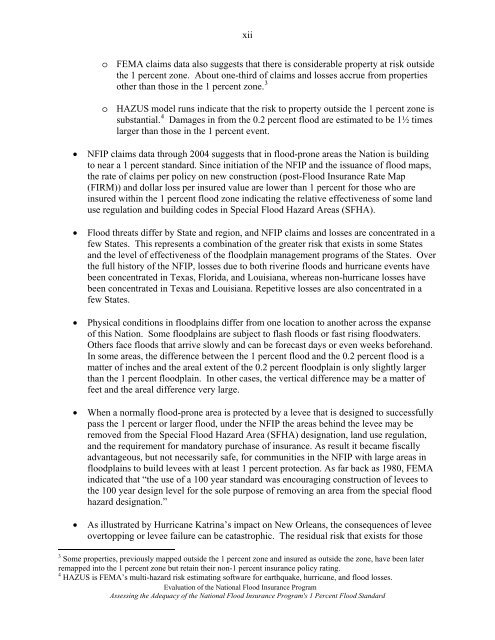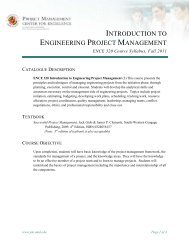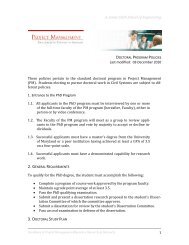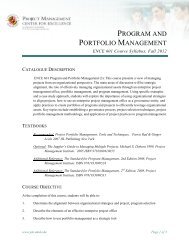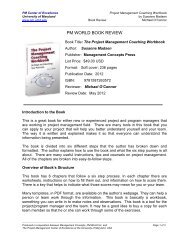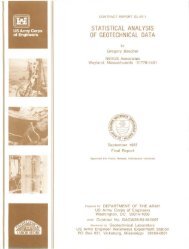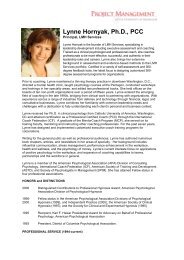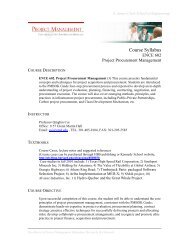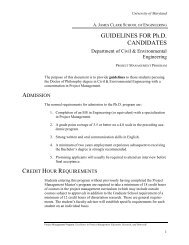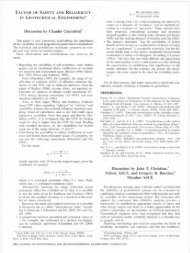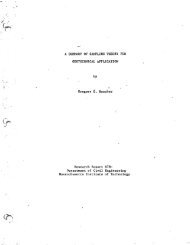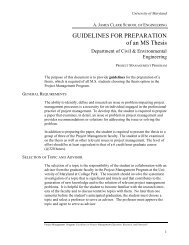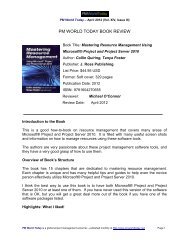Report Outline - Project Management at the University Of Maryland
Report Outline - Project Management at the University Of Maryland
Report Outline - Project Management at the University Of Maryland
You also want an ePaper? Increase the reach of your titles
YUMPU automatically turns print PDFs into web optimized ePapers that Google loves.
xiio FEMA claims d<strong>at</strong>a also suggests th<strong>at</strong> <strong>the</strong>re is considerable property <strong>at</strong> risk outside<strong>the</strong> 1 percent zone. About one-third of claims and losses accrue from propertieso<strong>the</strong>r than those in <strong>the</strong> 1 percent zone. 3o HAZUS model runs indic<strong>at</strong>e th<strong>at</strong> <strong>the</strong> risk to property outside <strong>the</strong> 1 percent zone issubstantial. 4 Damages in from <strong>the</strong> 0.2 percent flood are estim<strong>at</strong>ed to be 1½ timeslarger than those in <strong>the</strong> 1 percent event.• NFIP claims d<strong>at</strong>a through 2004 suggests th<strong>at</strong> in flood-prone areas <strong>the</strong> N<strong>at</strong>ion is buildingto near a 1 percent standard. Since initi<strong>at</strong>ion of <strong>the</strong> NFIP and <strong>the</strong> issuance of flood maps,<strong>the</strong> r<strong>at</strong>e of claims per policy on new construction (post-Flood Insurance R<strong>at</strong>e Map(FIRM)) and dollar loss per insured value are lower than 1 percent for those who areinsured within <strong>the</strong> 1 percent flood zone indic<strong>at</strong>ing <strong>the</strong> rel<strong>at</strong>ive effectiveness of some landuse regul<strong>at</strong>ion and building codes in Special Flood Hazard Areas (SFHA).• Flood thre<strong>at</strong>s differ by St<strong>at</strong>e and region, and NFIP claims and losses are concentr<strong>at</strong>ed in afew St<strong>at</strong>es. This represents a combin<strong>at</strong>ion of <strong>the</strong> gre<strong>at</strong>er risk th<strong>at</strong> exists in some St<strong>at</strong>esand <strong>the</strong> level of effectiveness of <strong>the</strong> floodplain management programs of <strong>the</strong> St<strong>at</strong>es. Over<strong>the</strong> full history of <strong>the</strong> NFIP, losses due to both riverine floods and hurricane events havebeen concentr<strong>at</strong>ed in Texas, Florida, and Louisiana, whereas non-hurricane losses havebeen concentr<strong>at</strong>ed in Texas and Louisiana. Repetitive losses are also concentr<strong>at</strong>ed in afew St<strong>at</strong>es.• Physical conditions in floodplains differ from one loc<strong>at</strong>ion to ano<strong>the</strong>r across <strong>the</strong> expanseof this N<strong>at</strong>ion. Some floodplains are subject to flash floods or fast rising floodw<strong>at</strong>ers.O<strong>the</strong>rs face floods th<strong>at</strong> arrive slowly and can be forecast days or even weeks beforehand.In some areas, <strong>the</strong> difference between <strong>the</strong> 1 percent flood and <strong>the</strong> 0.2 percent flood is am<strong>at</strong>ter of inches and <strong>the</strong> areal extent of <strong>the</strong> 0.2 percent floodplain is only slightly largerthan <strong>the</strong> 1 percent floodplain. In o<strong>the</strong>r cases, <strong>the</strong> vertical difference may be a m<strong>at</strong>ter offeet and <strong>the</strong> areal difference very large.• When a normally flood-prone area is protected by a levee th<strong>at</strong> is designed to successfullypass <strong>the</strong> 1 percent or larger flood, under <strong>the</strong> NFIP <strong>the</strong> areas behind <strong>the</strong> levee may beremoved from <strong>the</strong> Special Flood Hazard Area (SFHA) design<strong>at</strong>ion, land use regul<strong>at</strong>ion,and <strong>the</strong> requirement for mand<strong>at</strong>ory purchase of insurance. As result it became fiscallyadvantageous, but not necessarily safe, for communities in <strong>the</strong> NFIP with large areas infloodplains to build levees with <strong>at</strong> least 1 percent protection. As far back as 1980, FEMAindic<strong>at</strong>ed th<strong>at</strong> “<strong>the</strong> use of a 100 year standard was encouraging construction of levees to<strong>the</strong> 100 year design level for <strong>the</strong> sole purpose of removing an area from <strong>the</strong> special floodhazard design<strong>at</strong>ion.”• As illustr<strong>at</strong>ed by Hurricane K<strong>at</strong>rina’s impact on New Orleans, <strong>the</strong> consequences of leveeovertopping or levee failure can be c<strong>at</strong>astrophic. The residual risk th<strong>at</strong> exists for those3 Some properties, previously mapped outside <strong>the</strong> 1 percent zone and insured as outside <strong>the</strong> zone, have been l<strong>at</strong>erremapped into <strong>the</strong> 1 percent zone but retain <strong>the</strong>ir non-1 percent insurance policy r<strong>at</strong>ing.4 HAZUS is FEMA’s multi-hazard risk estim<strong>at</strong>ing software for earthquake, hurricane, and flood losses.Evalu<strong>at</strong>ion of <strong>the</strong> N<strong>at</strong>ional Flood Insurance ProgramAssessing <strong>the</strong> Adequacy of <strong>the</strong> N<strong>at</strong>ional Flood Insurance Program's 1 Percent Flood Standard


